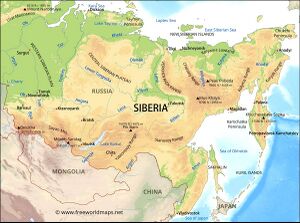Siberia
| Author: Laxman Burdak, IFS (R) |

Siberia (Russian: Сибирь, tr. Sibir' [sʲıˈbirʲ] is a vast region, constituting almost all of Northern Asia. Comprising the central and eastern portion of the Russian Federation, it was part of the Soviet Union (USSR) from its beginning, as the preceding Russian Empire conquered it in the 16th century.
Territory of Siberia
Encompassing much of the Eurasian Steppe, the territory of Siberia extends eastward from the Ural Mountains to the watershed between Pacific and Arctic drainage basins, and southward from the Arctic Ocean to the hills of north-central Kazakhstan and the national borders of both Mongolia and China.[1]
Some sources[2] say that the name is derived from the Turkic for "sleeping land." Another version is that this name was the tribal name of the Sibilla, ancient Turkic nomads later assimilated to Siberian Tatars. It has also been asserted that the name Siberia is connected to the Sabir people. The modern usage of the name appeared in the Russian language after the conquest of the Siberia Khanate.
History
Siberia was occupied by differing groups of nomads such as the Yenets, the Nenets, the Huns, the Iranian Scythians, and the Turkic Uyghurs. The Khan of Sibir in the vicinity of modern Tobolsk was known as a prominent figure who endorsed Kubrat as Khagan in Avaria in 630. The area was conquered by the Mongols early in the 13th century. With the break up of the Golden Horde, the autonomous Siberia Khanate was established in late 14th century.
The growing power of Russia to the west began to undermine the Siberian Khanate in the 16th century. First, groups of traders and Cossacks began to enter the area, and then the Russian army began to set up forts further and further east. Towns like Mangazeya, Tara, Yeniseysk, and Tobolsk sprang up, the latter being declared the capital of Siberia. By the mid-17th century, the Russian-controlled areas had been extended to the Pacific. The total Russian population of Siberia in 1709 was 230,000.[3]
Siberia remained a mostly undocumented and sparsely populated area. During the following few centuries, only a few exploratory missions and traders entered Siberia. The other group that was sent to Siberia consisted of prisoners exiled from western Russia or Russian-held territories like Poland (see katorga). In the 19th century, around 1.2 million prisoners were deported to Siberia.[4]
Aryan city discovered in Siberia

- See more in Aryan
Russian archaeologists have unearthed some ancient and virtually unknown settlements, which they believe were built by the original Aryan race about 4,000 years ago.[5]
According to the team which has discovered 20 spiral-shaped settlements in remote Russia steppe in southern Siberia bordering Kazakhstan, the buildings date back to the beginning of the Western civilisation in Europe.
The Bronze Age settlements, experts said, could have been built shortly after the Great Pyramid, some 4,000 years ago, by the original Aryan race whose swastika symbol was later adopted by the Nazis in the 1930s.
TV historian Bettany Hughes, who explored the desolate part of the steppe for BBC programme ‘Tracking The Aryans,' said, “Potentially, this could rival ancient Greece in the Age of the Heroes.”
Siberia yields 33,000 year old dog skull
A Russian-led international team of archaeologists has found a 33,000 year old canine skull from a cave in the Siberian Altai mountains. According to the study published in the open access journal Plos One, the well-preserved remains are among the oldest evidence of dog domestication ever found. The skull is different from modern dogs or wolves in some ways. Studies dated the bone to a time before the peak of the last ice age, the state-funded BBC reported. The snout is similar in size to early, fully domesticated Greenland dogs from 1,000 years ago, but its large teeth look like those of 31,000 year-old wild European wolves. According to evolutionary biologist Dr. Susan Crockford of Pacific Identifications, these qualities indicate a dog in the very early stages of domestication. "The wolves were not deliberately domesticated, the process of making a wolf into a dog was a natural process," she explained adding “at this time, people were hunting animals in large numbers and leaving large piles of bones behind, and that was attracting the wolves.” The least fearful wolves had more juvenile characteristics with shorter, wider snouts and smaller, more crowded teeth that came to define the domesticated dog over time. Oxford University archaeologist Professor Thomas Higham believes the early dogs helped people with cleaning up scraps and fending off other predators, but they became key members of the team after the Ice Age. "When you've got hunting dogs, all of a sudden it's a game changer. Hunters with dogs are much better than sole hunters," he said.[6]
Siberia in Jat history
According to Thakur Deshraj after the Mahabharata war many tribes moved to Uttar Kuru. Some of them settled in Punjab in the area known as "Yadu ki Dung", some settled in Kashmir and the rest moved far north up to Siberia. If this is true then we should find traces of these tribes in this region. The Jat historians refere to Siberia while mentioning history of some Jat Clans.
- Sibi - Hukum Singh Panwar attributes the name Siberia to Sibi Aryas . Sibi is a Jat clan. He writes that The colonization of the Anau or Anav region in the north-east of the Caspian sea as well as of the eastern and western Scythia, (as the names suggest), is unmistakably reminiscent of the settlement of the Anus and Sakas and Dahae (Dasas of the Rigveda) there in the remote past. There is no great improbability in the surmise that Siberia owes its name to Sibi Aryas and Mangolia to Mann and Golia or Gulia, the two Aryan tribes, followers of Agastya Man or Mandharia, who is known in ancient Indian literature as an Aryan coloniser of far-flung countries in the north and south of ancient India. [7]
- Sibi Jat Clan - According to Thakur Deshraj the Shivi gotra Jats of Shivaliks and lower reaches of Lake Manasarowar left this area after the war of Mahabharata and migrated to Uttar Kuru. Some of them settled in Punjab in the area known as "Yadu ki Dung", some settled in Kashmir and the rest moved far north upto Siberia.
- The Krishna vanshi people in Sanskrit were called "Karshney" and "Karshniya". Karshniya or Kasaniya is a gotra of Jats found in Rajasthan. These Krishna vanshi people in China were known as Kushan or Yuezhi.
- Ola Jat clan - We find mention of Ola in Central Asia in the form of a mountain. The Tannu-Ola mountains (Tuvan: Таңды-Уула Tangdy-Uula mountains) is a mountain range in southern Siberia, in the Tuva Republic of Russia. It extends in an east-west direction and curves along the Mongolian border. Its highest peaks reaches 2,930 m.
- Burdak Clan - Some historians consider the Buryat people of Siberia to be connected with Burdak Clan. Burdak → Burjak (d ↔ j) → Buryak (j ↔ y) → Buryat
- Bura Jats - Buryats are the Burjats (Buryat → Burjat) (j ↔ y) or Bura Jats, living in the Steppes on the Dena river Russia.[8]
- Jakhar - According to [9]The Soviet Scientists found to their surprise that Yakutian nationality, living in remote Siberia, have in their blood the "HLA - B 70" antigen, which is possessed only by the Hindus of north India (The Indian Express, Chandigarh, dt. Oct. 24,1988). We surmise that, as the name suggests, the Yakuts must be Yakhus = Jakhus or in Sanskrit Yakshus and in Prakrit Jakhus (Jakhar Jats), who lived in the Drishad and Sarasvati Doab in the Rigvedic period and who were expelled to northern countries after their defeat in the last battle of the Dasharajna wars by the Bharatas and who, according to M.L. Bhargava, (who made an elaborate ethno-geographical study of the Sapta-Saindhava country of the Rigvedic period), gave their name as Yakhu (Oxus in Greek) and Yakshar (Jaxartes in Greek) to two rivers between the Aral sea and lake Balkhas (infra, ch. IX on migrations of Jats).
Major cities include:
- Barnaul
- Irkutsk
- Kemerovo
- Krasnoyarsk
- Novokuznetsk
- Novosibirsk
- Omsk
- Tomsk
- Tyumen
Lakes and rivers
- Anabar River
- Angara River
- Indigirka River
- Irtysh River
- Kolyma River
- Lake Baikal
- Lena River
- Lower Tunguska River
- Novosibirsk Reservoir
- Ob River
- Popigay River
- Stony Tunguska River
- Upper Angara River
- Uvs Nuur
- Yana River
- Yenisei River
Mountain ranges
- Altai Mountains
- Anadyr Range
- Baikal Mountains
- Chamar-Daban
- Chersky Range
- Dzhugdzhur Mountains
- Gydan Mountains
- Koryak Mountains
- Sayan Mountains
- Tannu-Ola Mountains
Demographics
Siberia has a population density of about four people per square kilometer. Most Siberians are Russians and Russified Ukrainians. There are approximately 400,000 Russified ethnic Germans living in Siberia. Such Mongol and Turkic groups as Buryats, Tuvinians, Yakuts, and Siberian Tatars lived in Siberia originally, and descendants of these peoples still live there. The Buryats number 445,175, which makes them the largest ethnic minority group in Siberia.[10] According to the 2002 census there are 443,852 Yakuts.[11] Other ethnic groups include Kets, Evenks, Chukchis, Koryaks, and Yukaghirs.
About 70% of Siberia's people live in cities. Most city people live in apartments. Many people in rural areas live in simple, but more spacious, log houses. Novosibirsk is the largest city in Siberia, with a population of about 1.5 million. Tobolsk, Tomsk, Krasnoyarsk, Irkutsk and Omsk are the older, historical centers.
जाट इतिहास
डॉ रणजीतसिंह[12] लिखते हैं ...शिवदास गुप्ता[13] ने 'जाटों का विस्तार' के संबंध में अपने विचार इस प्रकार प्रकट किए हैं- "जाटों ने तिब्बत, यूनान, अरब, ईरान, तुर्किस्तान, जर्मनी, साइबेरिया, स्कैंडिनेविया, इंग्लैंड, ग्रीक, रोम तथा मिस्र में कुशलता, दृढ़ता और साहस के साथ राज्य किया और वहां की भूमि को विकासवादी उत्पादन के योग्य बनाया था।"
References
- ↑ словари. "Great Soviet Encyclopedia (in Russian)". Encycl.yandex.ru.
- ↑ Healing oils from pristine Siberian wilderness, publisher - Siberiantigernaturals.com
- ↑ Sean C. Goodlett. "Russia’s Expansionist Policies I. The Conquest of Siberia". Falcon.fsc.edu.
- ↑ Carl De Keyzer, Zona at the Impressions Gallery, BBC
- ↑ http://www.thehindu.com/news/international/article812961.ece
- ↑ Press TV 6 August 2011
- ↑ The Jats:Their Origin, Antiquity and Migrations:p.242
- ↑ The Jats:Their Origin, Antiquity and Migrations:p.241
- ↑ The Jats:Their Origin, Antiquity and Migrations: Section four, p. ii
- ↑ World Directory of Minorities and Indigenous Peoples - Russian Federation : Buryats
- ↑ World Directory of Minorities and Indigenous Peoples - Russian Federation : Yakuts
- ↑ Jat Itihas By Dr Ranjit Singh/1.Jaton Ka Vistar, p.3
- ↑ शिवदास गुप्ता, स्वार्थ पत्रिका अंक 4-5, 1976
See also
External links
- Ancestral Scythian migration of Jatt people (or Jat people)
- Scythian Gold From Siberia Said to Predate the Greeks - New York Times | By JOHN VAROLI - Published: January 09, 2002
- Frozen Siberian Mummies Reveal a Lost Civilization | Archaeology | DISCOVER Magazine - by Andrew Curry | From the July 2008 issue; published online June 25, 2008
- The place where Europe began: Spiral cities built on remote Russian plains by swastika-painting Aryans | Mail Online
Back to Places

